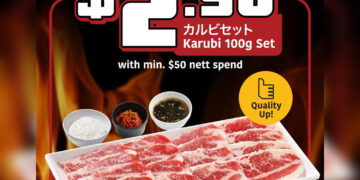
Examining the charcoal claypot trend in Singapore

2024 saw the rise of numerous food trends such as coin pancake, kunafa, smashed croissants and more. But we’ve noticed one in particular that has a unique staying power: charcoal claypot.
While claypots have always been a cornerstone of local cuisine, there seems to be a renewed interest in using the cooking vessel in novel ways this year. Things kicked off with the viral charcoal claypot lala, but shortly after, charcoal claypot chicken, claypot prawn, and even claypot pasta emerged, sparking a bona fide trend.

We’ve likened it to something of an arms race, with each new stall seemingly trying to outdo the last with whatever claypot-plus-something concoction they come up with. But at some point, one has to wonder if they were so preoccupied with whether or not they could, they didn’t stop to think if they should.
If you’ve found yourself wondering about this trend, fret not—we’ve got you covered. Having visited many of these spots when they first opened, we decided to dig into their origins and make sense of this curious phenomenon.
10 Charcoal Claypot Places For Famous Lala Hotpot, Prawn Collagen Broth And More
What is this charcoal claypot trend, anyway?

The use of claypots in local cuisine can be traced back to the early 19th century, when Chinese immigrants brought their culinary traditions to Singapore. This led to dishes such as claypot rice and claypot fish head curry becoming mainstays in our food culture. In more recent times, there have been innovative uses of claypot here and there, with eateries including Lau Wang Claypot and Kim Keat Hokkien Mee putting spins on their signature dishes with clay cookware.
This latest trend, however, can be attributed to the claypot lala hotpot from Kuala Lumpur’s Dai Tao Lala Pot.

Served on a charcoal stove with a flavourful broth of lala clams, ginger, Shaoxing wine and more, with optional sides to enjoy hotpot-style, the claypot lala took social media by storm. When Dai Tao launched an outlet in JB last year, Singaporeans crossed the border just to have a taste of this exciting new dish.
Perhaps it’s no surprise the dish became a hit. It essentially combines claypot cooking, hotpot dining, and fresh seafood—three things that Singaporeans love—into one package. And it wasn’t a gimmick, either. Our writers raved about it, describing it as having a “rich, aromatic seafood soup with juicy, plump clams”.
It didn’t take long for local food entrepreneurs to take notice. In January 2024, Ubi Claypot Lala became the first stall in Singapore to offer claypot lala, opening the floodgates for several others to follow suit.

But it wasn’t just claypot lala. The charcoal claypot prawn concept arrived shortly after, with Woodlands Claypot Prawn and Hae! Prawn Claypot being prominent examples. The folks behind the former even decided to take things further with Charcoal Claypot Crab. All these stalls offered the charcoal-fire-plus-claypot combo and hotpot sides, except that prawns and crabs were the central ingredients of their respective dishes instead of lala.

A Charcoal Claypot Chicken also opened around the same period, serving claypot soup over a charcoal fire and hotpot-style sides—but with the key difference being the broth, which is based on chicken instead. Although this particular stall is said to be directly inspired by a Guangdong-style hotpot, its emergence during this wave of new claypot stalls is perhaps no coincidence.
Charcoal Claypot Chicken Review: Guangdong-Style Claypot Soup In Farrer Park
The nuances of claypot cooking
While the rise of charcoal claypot stalls is certainly exciting, it’s worth asking: does cooking these dishes in a claypot actually make a difference? As with most things, the answer depends.
The thing with claypots is that these contraptions have numerous benefits. They’re great for slow cooking, as they evenly distribute heat, retain moisture, and enhance flavours. The exact science of how this all happens is still up for debate, but as this article from TASTE suggests, food cooked in a claypot “takes on a softer, rounder quality”, with “subtle earthy and smoky flavours and aromas as well”.

These qualities naturally lend themselves to hotpot dishes such as claypot lala. The slow-cooking properties of the claypot help all the elements, including the clams, Shaoxing wine, and other hotpot ingredients, meld together, thus intensifying and enhancing the overall taste. This results in a highly aromatic and umami-filled broth that keeps people coming back for more.
But in the case of the claypot prawn and claypot crab concepts, things get a little trickier. While lala can be simmered for long periods without becoming too tough or rubbery, prawns and crabs can quickly become overcooked.

That was what we experienced when reviewing some of these claypot prawn stalls. When the prawns were placed into the claypot at the beginning and cooked continuously over the charcoal fire, they quickly became tough and dry—even the claypot’s slow-cooking qualities couldn’t prevent that. The broth was delicious, yes, but the prawns were unfortunately compromised.
This was even more of an issue with the claypot crab. By the time we were ready to dig into the crab, we found that its meat was far less succulent than it could’ve been if it had been cooked in a more controlled environment.
In short, the claypot’s slow, steady heat is ideal for simmering ingredients over time, but prawns and crabs are prepared best with quick heat to avoid them overcooking and losing their texture. The claypot’s heat retention, combined with the charcoal’s constant burn, makes it hard to adjust the temperature, potentially overheating the broth and compromising the seafood’s delicate texture.

There are of course ways to mitigate this, such as by adding the seafood ingredients after the broth is already boiling, and only letting it simmer for a shorter period of time. You could also use a gas or induction cooker instead of charcoal, so as to control the fire for more delicate ingredients.
On the charcoal point: while it can improve flavours when it comes to grilling long-cooking meats—charcoal releases guiaicol, a chemical responsible for that smoky flavour—not much has been discussed about whether it enhances the taste of soups. So whether the charcoal fire is even necessary for these dishes is up for debate as well.
There’s no doubt that this charcoal claypot formula can produce an excellent dish, but it has to be cleverly implemented for the benefit of its ingredients.
The future of the claypot renaissance
The charcoal claypot trend can only sustain so many variations before it runs out of steam—and it already seems to have cooled off in recent months. However, its popularity, along with the continued success of eateries that utilise the claypot, suggests that we will likely see new claypot-plus-something dishes emerge beyond 2024. The question remains: when does this trend become just another fad?

We recently tried Singapore’s first claypot pasta stall, Super Cheesy Western Claypot Pasta. The writer that reviewed this place found that the “claypot did not do much to enhance the flavours”. While this is just the opinion of our writer, the fact remains that if the claypot does not add anything to a particular dish, then it could be just a gimmick and nothing more.
Perhaps next we’ll see a claypot nasi lemak, or even a claypot wonton mee. If things ever come to that, then we can definitively say that this claypot thing has really gone too far.
For a story about a 73-year-old uncle who has been selling $2 chicken rice since 1996, read our Fook Seng GoldenHill Chicken Rice feature. For a look at what makes good hokkien mee according to Singapore’s most famous stalls, read our hokkien mee feature.
Meet The 73-Year-Old Uncle Who Has Been Selling $2 Chicken Rice Since 1996
This was an independent feature by Eatbook.sg.
The post The Charcoal Claypot Trend Of 2024—Is It Just Another Gimmick? appeared first on EatBook.sg – Local Singapore Food Guide And Review Site.






